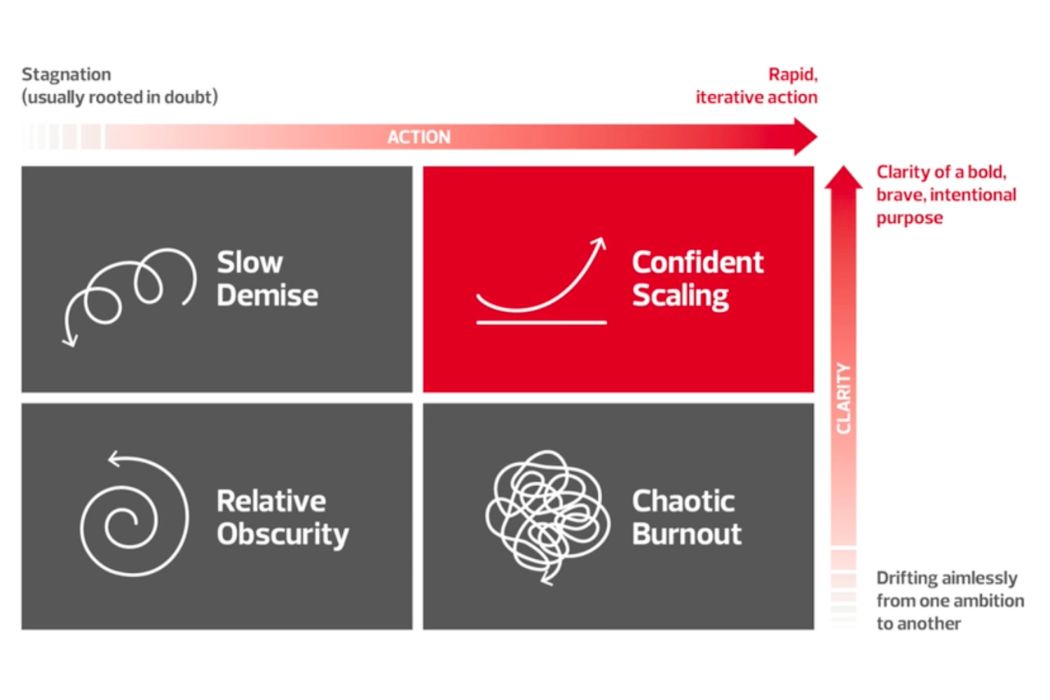Startup leaders are accustomed to the mantra of ‘move fast and break things’ because this growth-at-all-costs mentality produced some of the largest companies the world has ever known. But along with it came intense working hours and mental health risks for founders and employees.
Successfully moving away from autocratic leadership requires the right kind of communication.
BASE Associates, a startup growth consultancy, takes a different approach: ‘scale together’, a mantra based on clarity of focus leading to more conscious actions. In a webinar presented by CDW and Cisco, Brent Lowe, the founder of BASE Associates, explained the common traps founders fall into when trying to scale.
Avoid action-driven chaos
Lowe starts all his projects by asking founders to envision a future where their company is two-to-four times the size it is today, specifically: how many people are working there, what it’s like working for the company, how people work together, and what it feels like for the founder as an individual within the space.
While the answers vary depending on entrepreneurial ambitions, Lowe said founders will often end up in one of three traps as they work to build their newly-envisioned future. The first trap is burnout: Lowe explained that burnout comes when an overwhelmed founder feels like “‘I’m giving all of the energy that I have and it’s just not enough. I’ve got nothing left to give.’”
The second trap comes from chaos and performance issues—when the founder has delegated so much yet there’s no cohesive plan at the top.
“It’s this experience of looking around and feeling like they’re in the midst of chaos and they’ve kind of lost control of what’s going on,” said Lowe.

The third trap is a founder’s doubt in their ability to lead.
“Some would call it imposter syndrome,” said Lowe. “‘I was the entrepreneur. I was the visionary that came up with this idea. And now there are all these people. Am I up to the task of leading this organization?’”
Start with clarity and communication
The first step away from chaos and toward ordered growth, said Lowe, is clarity on the “why” of the business. From there, Lowe said founders need to create three to five “guardrails” (a.k.a. values) that help anchor the team from a behavioural and decision-making perspective.
“It’s not possible for the founder to hold all of the decisions and to have a rapidly scaling organization,” said Lowe. “So you’ve got to figure out how to move away from autocratic without crossing over into consensus where everybody feels like they have to have a say all the time.”
Successfully moving away from autocratic leadership requires the right kind of communication. In the early days when the team is small, explained Lowe, communication happens more organically because institutional memory is held by only a few people. As you grow, communication flows help ensure knowledge isn’t lost. One tool Lowe encourages all founders to consider is hosting retrospectives, ensuring every key project has time afterward to assess what worked, what didn’t, and how individuals can improve.
Commitment and consistency come next
Once you have found clarity of vision and successful communication you need systems that encourage commitment and consistency. Lowe advocates starting with role definitions—a few bullet points explaining what the role is accountable for—then co-creating “agreements” rather than policies with employees. These agreements include a shared understanding of the role and what each individual in that role commits to.
When it comes to how often people meet and what agenda they follow, Lowe advocates a minimalistic approach and adding or taking away as needed. Here he again cites retrospectives as useful tools for identifying necessary changes.
“We can have a tendency to over-engineer processes and so we tend to start light, use retrospectives to clean them up and distil them over time,” said Lowe.
Last comes planning for your employees’ journey through the company, from recruitment to onboarding, team development, and exit. To Lowe, onboarding is the most critical part of the career lifecycle since that’s how you train employees, introduce them to the organization, and get them up to speed quickly. He advises all founders to build a checklist for onboarding, starting with all “artifacts and assets” employees need to be introduced to. This might be specific training, technology, or information to help them get used to the business and their new role, and can be adjusted after each onboarding if you notice any gaps.
After creating an onboarding plan, Lowe recommends setting up a mentorship program, even if only informal, so new employees have someone they can turn to for support beyond your onboarding checklist. He then advocates a specific retrospective for new team members after two months on the job, with three to five of their colleagues. In a 30-60 minute meeting, Lowe recommends giving space for the new employee to provide feedback on their experience so far so the team can learn how to best support the employee going forward, whether that’s additional information, processes, or feedback in kind.
The confidence to scale
Startup leaders are often unsure about adding too much process to their company for fear of stifling innovation. Sometimes they simply question their own ability to add the right processes.
While this uncertainty is reasonable, it stops a company in its tracks when it wants to scale. As you grow, complexity explodes in a non-linear way, risking total chaos if it’s not reigned in—founders need to find the confidence to take the necessary steps to scale in an ordered and predictable way.
“As the business continues to grow and there are more and more people joining and being onboarded to the organization, we need to have some predictability that people can grab on to and help guide them in their work,” said Lowe.
Photo courtesy of Unsplash.


